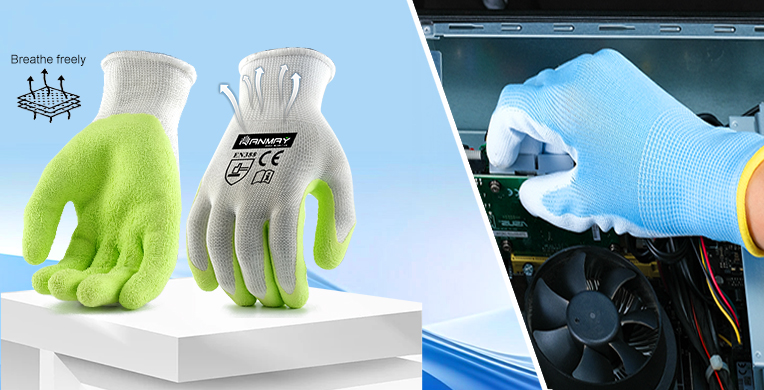
Importing protective gloves may seem like a simple task, but it involves several crucial steps. From identifying the right supplier to ensuring compliance with local regulations, it’s essential to follow a detailed process to ensure smooth importation.
The process for importing protective gloves typically includes choosing a supplier, ensuring product quality and certification, complying with regulations, arranging logistics, and finalizing customs clearance.
If you’re new to importing gloves, understanding each of these steps can be overwhelming. But don’t worry—we’ll break it down for you so you can approach it with confidence.
How do you choose the right supplier for protective gloves?
Finding a trustworthy supplier is the first step in importing protective gloves. It can make or break the success of your import process.
Choosing the right supplier involves evaluating factors like product quality, reliability, cost, and the ability to meet your specific needs, including customization and certification requirements.
When sourcing protective gloves, it’s important to consider the country of origin and the supplier’s experience in exporting. A supplier who has been in the industry for years, like Anmay Protective Tech, can offer better insight into international standards and product quality. Always check whether the gloves have certifications like CE marks, which confirm their compliance with safety standards.
Additionally, ask for product samples before committing to bulk orders. Testing these samples allows you to evaluate material quality, comfort, and durability. Keep in mind that prices can vary significantly depending on the supplier, so a balance between cost and quality is essential.
What are the international standards for protective gloves?
To ensure your gloves are safe and effective, you must understand the relevant international standards they must meet. But what are these standards?
Protective gloves are subject to various standards, including CE certification in Europe and ANSI standards in the U.S., which ensure safety and performance in specific industries.

The CE mark is essential for gloves sold in Europe, ensuring that the product meets health, safety, and environmental protection standards. For gloves to be CE-certified, manufacturers must undergo rigorous testing, which is often conducted in specialized labs.
In the U.S., protective gloves must meet standards set by the American National Standards Institute (ANSI). For example, ANSI/ISEA 105 is the standard for hand protection, specifying the performance and testing methods for cut-resistant gloves, impact-resistant gloves, and more.
Knowing these standards will help you avoid costly mistakes, such as importing non-compliant gloves that cannot be sold in your target market.
How does shipping and logistics work when importing gloves?
Once you’ve secured your supplier and ensured compliance with standards, it’s time to look at the logistics side of importing gloves. This step can be complex but is crucial for timely delivery.
Shipping involves selecting the right mode of transportation, choosing the appropriate incoterms, and managing delivery timelines to ensure your gloves arrive safely and on time.

There are several shipping options available, including sea freight, air freight, and land transport. Each option has its own benefits and drawbacks depending on your needs, such as cost, delivery time, and volume.
For large shipments, sea freight is usually the most cost-effective option, although it takes longer. Air freight is faster but more expensive, making it ideal for smaller orders or urgent deliveries. In terms of incoterms, FOB (Free On Board) and CIF (Cost, Insurance, and Freight) are two common terms you’ll encounter. FOB means the seller covers the cost until the goods are loaded onto the ship, while CIF includes the cost of shipping and insurance.
Understanding these factors is key to managing your logistics smoothly and avoiding unexpected delays or extra costs.
How does customs clearance work when importing gloves?
Customs clearance can be a daunting part of the import process, but it doesn’t have to be. Knowing what documents are required and how to prepare for inspections will ease the process.
Customs clearance involves submitting the correct documentation, paying duties and taxes, and ensuring your goods comply with regulations before they are released for distribution.
Every country has its own customs procedures, so it’s important to familiarize yourself with the regulations in your importing country. For protective gloves, you’ll typically need the commercial invoice, packing list, certificate of origin, and any relevant product certifications like CE marks. Some countries may require a customs bond or specific permits, especially if you’re importing in large quantities.
Make sure your documentation is accurate to avoid delays. Customs authorities often inspect goods, and if any discrepancies are found, your shipment could be held up or fined. It’s wise to work with a freight forwarder or customs broker who can guide you through the process.
How can you avoid common importing pitfalls?
Importing gloves can be a tricky business, with many potential pitfalls. But knowing what to watch out for can save you time and money.
Common pitfalls include failing to understand regulations, choosing unreliable suppliers, and underestimating shipping and customs costs. Preparation is key to avoiding these mistakes.

One common mistake is underestimating the total cost of importing, including shipping, insurance, and customs duties. Many first-time importers focus solely on the price of the gloves but overlook these additional expenses.
Another pitfall is choosing suppliers without conducting proper due diligence. It’s essential to verify their reputation, product quality, and certifications. Without these checks, you risk importing gloves that don’t meet industry standards, resulting in costly returns or customer dissatisfaction.
Lastly, make sure to stay informed about any changes in international trade laws or regulations that could impact your imports.
Conclusion
Importing protective gloves is a multi-step process involving supplier selection, regulatory compliance, shipping, and customs clearance. With the right approach, you can ensure smooth and successful importation.
